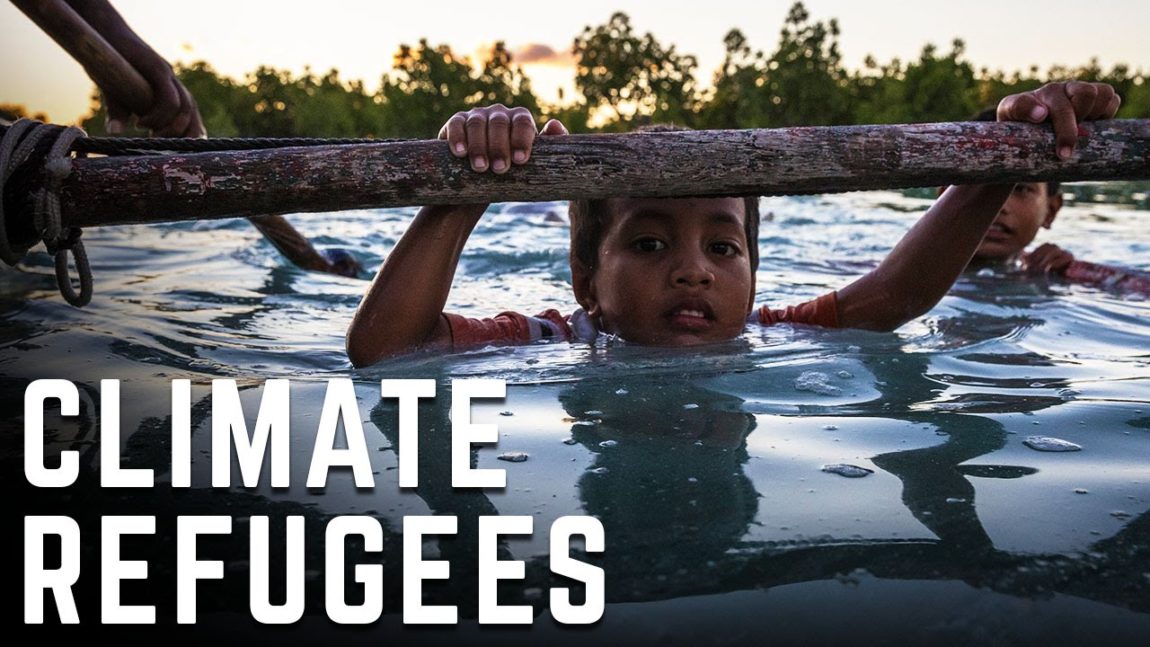
What protection for the so-called climate refugees?
Table of contents: 1. Introduction – 2. Towards a new legal notion – 3. Geneva Refugee Convention of 1951 and Protocol of 1967 – 4. European Asylum Legal Framework and Temporary Protection Directive – 5. United Nations Framework Convention on Climate Change – 6. Conclusions
1. Introduction
It is well known that climate change and environmental disasters have a great impact on migration flows both directly and indirectly. On the one hand, the so-called rapid onset natural disasters (such as earthquakes, tsunamis, eruptions…) force people to leave their habitual homes looking for a place where they can resettle and have a chance of survival; on the other hand, the so-called slow onset natural disasters (rising sea level, drought, insect infection, desertification…), together with socio-economics reasons, could have a relevant influence in the decision of migrating elsewhere.
As it was stressed in the report “Grounswell – Preparing for internal climate migration” by the World Bank, 143 million people from the Sub-Saharan Africa, South Asia and Latin America areas will probably flee their regions and will be internally displaced by 2050.
On this basis, the aim of this contribution is to assess whether an international legal framework for the protection of the so-called environmental refugees/migrants exists or not and what viable solutions could be provided.
2. Towards a new legal notion
As it was stressed in the introduction, climate-change and harsh living conditions are already determining the displacement of many individuals.
So far, the international response to this new challenge has been lukewarm, considering that the protection offered to the individuals affected by environmental disasters is insufficient and inadequate.
The international community, including the UN Refugee Agency, NGOs and academic researches, make use of a large number of expressions to describe this phenomenon, but these are merely descriptive terms.
At the time being, there are not accepted definitions for the environmental-related migrants; as a consequence, the lack of a common legal basis prevents from a concerted action for the protection of these individuals.
The most commonly used definitions are environmental refugees, environmental migrants and environmentally displaced persons.
With regard to the first definition, it was coined by E. El-Hinnawi, an UN environmental expert, who defined environmental refugees as “people who have been forced to leave their traditional habitat, temporary or permanently, because of marked environmental disruption that jeopardized their existence and/or seriously affected the quality of their life”.
In truth, both the UNHCR and many academic scholars have criticized the use of the term “refugee” because it has a specific legal meaning within the Geneva Refugee Convention, that does not include environmental disasters as ground for granting such protection.
On the contrary, the definition environmental migrant is far more common because it is presumed more neutral, considering that it does not evoke the previously mentioned Convention; even so, the IOM stigmatized the use of the term “migrant” on the assumption that it implies a degree of volition in the choice of leaving the country of origin or habitual residence. It was also stressed that it “carries negative connotations which reduce the implied responsibility of the international community for their welfare”.
Finally, the term environmentally displaced individuals is widely used for two main reasons: on the one hand, it underlines the importance of environmental factors in the migration dynamics, and, on the other hand, the expression “displaced individuals” does not necessarily imply the will of movement.
Nonetheless, the definition “displaced individuals” is not legally binding (the “Guiding Principles on Internal Displacement” address the need of “persons or group of persons who have been forced or obliged to flee or leave their homes or places of habitual residence (…) and who have not crossed an international recognized State border” and they do not create obligations like treaties).
3. Geneva Refugee Convention of 1951 and Protocol of 1967
According to Article 1(A)(2) of the abovementioned Convention, a refugee is a person who has a well-founded fear of being persecuted for reasons of race, religion, nationality, membership of a particular social group or political opinion and is outside of the country of his nationality, being unable or unwilling to receive protection from that country or, in case of statelessness, from the habitual place of residence.
The definition itself does not seem to be fit for those who are forced to flee their countries of origin due to environmental hazards for two main reasons: firstly, the term persecution is associated to serious violations of human rights or to the cumulation of less serious violations committed by the country of origin; secondly, both natural or human-made disasters do not fulfill any grounds of the Refugee Convention and its additional Protocol.
Nonetheless, it should be determined whether the so-called environmental refugees/migrants could be considered to be part of a particular social group and if, in that case, they would be entitled to claim for the refugee status. According to the UNHCR’s opinion, members of a particular social group must share a common and immutable trait or status that distinguish them from the others; given that, it would be hard to demonstrate that those who are affected by a natural disaster share a common and immutable trait or status.
When it comes to political opinions, it would be possible to grant the refugee status at certain conditions: if after an environmental disaster the population would claim that it was determined by the State or other governmental actors and, as a consequence, the former would be persecuted by the latter, it would be possible to assert that there are the grounds to apply the abovementioned Convention.
As far as it seems, one could affirm that the Geneva Refugee Conventional and its additional Protocol are not eligible to grant a legal protection or status to those who are facing the consequences of natural disasters. In addition, there is no political will to extend the Geneva Convention to the so-called environmental refugees/migrants because this would determine the collapse of this protection, considering that it is already strenuous and costly to process the asylum-requests and to accomodate all the asylum-seekers.
4. European Asylum Legal Framework and Temporary Protection Directive
On the basis of the Article 78 TFUE, the European Union created a common legal framework that is composed of three protection statuses: refugee status, subsidiary status and temporary status.
When it comes to the first mentioned, it is possible to assert that there is no difference between the definitions of refugee provided by the Geneva Convention and the “Qualification Directive” (2011/95/EU). Due to that reason, the same aforementioned considerations are valid to this form of protection within the EU borders.
Regarding the subsidiary status, it is applicable to individuals who cannot be considered refugees but are in need of protection. For clarity, the Art. 15 of the previous Directive establishes that this form of protection must be granted to those who would face a “real risk of suffering serious harm” in case of refoulment. In particular, the serious harms consist of: a)the death penalty or execution; b)torture or inhuman or degrading treatment or punishment in the country of origin; or, c)serious or individual thereat to a civilian’s life or person by reason of indiscriminate violence in situations of international or internal armed conflict.
Given that, it seems unlike the so-called environmental refugees/migrants could claim this protection regarding the situations described in letters a) and c).
Instead, it could be possible to affirm that only in case of extraordinary natural disasters the subsidiary protection could be granted to the individuals who would face certain death or extremely survival conditions in case of removal. In fact, the definition of serious harm under Art. 15, b) of the Qualification Directive corresponds to the provision of Art. 3 of the European Convention of Human Right (ECHR). According to the jurisprudence of the European Court of Human Rights, Art. 2 (right to life), Art. 3 (prohibition of torture), Art. 8 (right to respect for private and family life) and Art. 1 of the Protocol (protection of property) ECHR forbid a Contracting State to remove an individual who would have to face such severe violations of his human rights in the country of origin or habitual residence.
In fact, the European Court of Human Rights has recently stressed that the Convention does not ensure the protection of the environmental per se; nonetheless a serious environmental harm may affect individuals’ well-being and deprive them of enjoyment of their domicile, so as to compromise their rights to private life (see the joint applications nos. 54414/13 and 54264/15 Cordella and Others v. Italy).
In lights of those considerations, there is a narrow space for the recognition of the subsidiary protection in case of environmental disasters (such as: lack of food, non-drinkable water, poisoned soil, shortages of life-savings medicines and so on).
With regard to temporary protection, the 2001/55 EC Council Directive establishes that its aim is to provide “immediate” and “temporary” protection to a mass influx of displaced foreign nationals that were forced to leave or were evacuated from their countries or places of habitual residence and cannot return in “safe and durable conditions because of the situation prevailing in that country (Art. 2(b)).
Firstly, one should consider that “mass influx” means a large number of displaced individuals that come from “a space country or geographical area”: it is to say that this legal instrument cannot be used for granting protection to a single individual.
It is also important to underline that the TD is applicable only in case of exceptional and adverse events that would endanger the lives of third-national individuals such as a) armed conflict or endemic violence; b) risk of systemic or generalized violations of human rights.
As far as it seems, natural disasters are not mentioned; nonetheless, the TD could be activated in case of sudden onset environmental disasters that would represent a serious thereat to human life.
As a matter of fact, the Temporary Directive could potentially be regarded as a form of protection for groups of displaced individuals who have to face sudden onset natural disasters; in spite of that, this form of protection is limited in time and it does not grant a permanent status as the political refugee one or to, to some extent, the one granted by the subsidiary protection.
In light of the considerations that we have shown up to this point, one could affirm that the European asylum legal framework and the temporary protection offer a limited protection for the so-called environmental refugees/migrants.
5. United Nations Framework Convention on Climate Change
The UNFCCC is an international environmental treaty adopted in Rio de Janeiro in 1992 and it entered into force in 1994, when it was ratified by a sufficient number of States.
Its aim is to address the issue of climate change in a global perspective, considering that this matter affects both developed and developing countries.
Given that this is not the context where to recall all the agreements made by the COPs in the last decades, it appears imperative to consider whether the so-called environmental refugees/migrants are granted any form of protection under this treaty and subsequent agreements.
With regard to the aforementioned question, neither the UNFCCC nor the subsequents agreements provide an international form of protection to the individuals and the populations affected by natural or human-induced disasters.
Paragraph 14 of the Cancun Agreement establishes that State Parties should heighten “understanding, coordination and cooperation with regard to climate change induced displacement, migration, and planned relocation, where appropriate at national, regional and international levels” and paragraph 49 of the Paris Agreement recognizes that climate change has an impact on migration flows and therefore establishes the necessity “to develop recommendations for integrated approaches to avert, minimize and address displacement related to the adverse impacts of climate change”.
It is undoubtedly clear that the aforementioned statements do not create any legal obligation to the Contracting States and, as a consequence, these ones could help the so-called environmental refugees/migrants on voluntary basis and for humanitarian reasons.
6. Conclusions
Overall, it may be said that at the time being a secure and substantial protection for the so-called environmental refugees/migrants does not exist.
The absence of a common legal definition regarding the climate change migrants prevents the introduction of a new international legal framework; in the meantime, it would be possible to opt for an extensive interpretation of the existing international legal framework, but in case of a mass influx of individuals it would reveal all its limitations dramatically.
As a matter of fact, the international community should embrace this complex matter and work together for a potential solution.
It is of utmost importance to find a common and shared definition of the concept of environmental/climate-change refugees/migrants.
It would be fruitful to compare the already existing international, regional and national legal framework that is related to this issue in order to “create” the most comprehensive form of protection.
Unfortunately, the state of affairs is far more complex; not only is it incumbent to adopt a new international legal framework, but also it is necessary to develop strategies for adaptation and provide a legitimate and sustainable process to finance it all.
The EU Commission in the Work Programme 2020 has thus stated: “the most pressing challenge, responsibility and opportunity for Europe is keeping our planet and people healthy. This is the defining task of our times. The increase in global temperature, the depletion of natural resources and continued biodiversity loss, together with increasing forest fires, floods and other natural disasters undermine our security and prosperity”.
Finally, the EU Commission expressed the will of coming “forward with a New Pact on Migration and Asylum” that will be “more resilient, more humane and more effective”.
Salvis Juribus – Rivista di informazione giuridica
Direttore responsabile Avv. Giacomo Romano
Listed in ROAD, con patrocinio UNESCO
Copyrights © 2015 - ISSN 2464-9775
Ufficio Redazione: redazione@salvisjuribus.it
Ufficio Risorse Umane: recruitment@salvisjuribus.it
Ufficio Commerciale: info@salvisjuribus.it
***
Metti una stella e seguici anche su Google News
The following two tabs change content below.
Gemma Giammattei
Laureata in Giurisprudenza con lode presso l'Università Cattolica del Sacro Cuore di Milano. Abilitata all'esercizio della professione forense dall'ottobre 2021, collabora con lo Studio Legale Giammattei.
Ultimi post di Gemma Giammattei (vedi tutti)
- In crisi (coniugale) ma con salvezza dei benefici fiscali sull’acquisto della casa famigliare - 8 Febbraio 2022
- ILO Convention 190: the “new” basic human rights in the world of work - 7 Luglio 2020
- Prove di bilanciamento tra il diritto alla privacy e il diritto alla salute (pubblica) - 14 Aprile 2020







